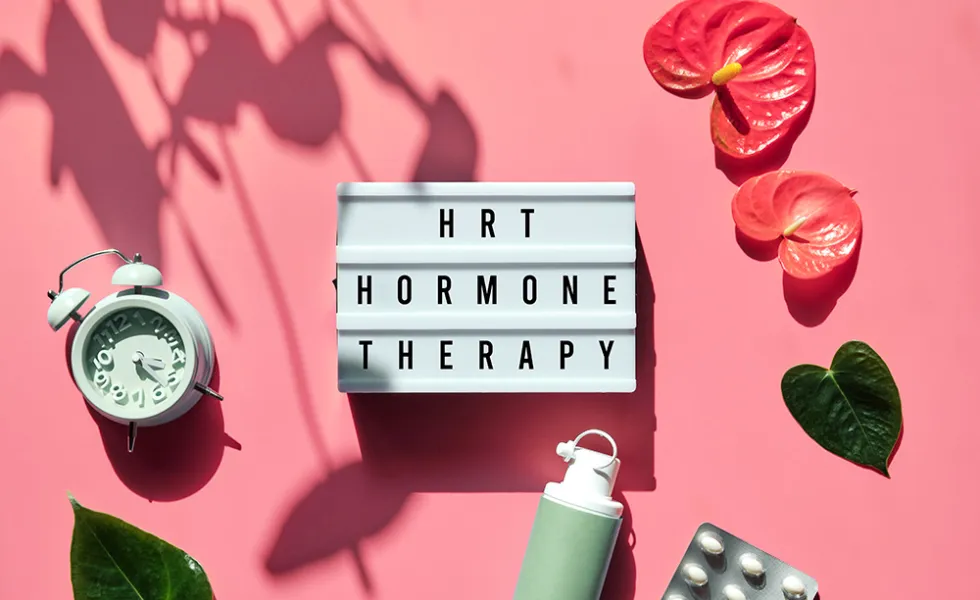Hormone Replacement Therapy (HRT) helps manage menopausal symptoms like hot flashes and mood swings. While concerns about cancer and heart disease exist, understanding facts and myths ensures informed decisions.
Introduction
Hormone replacement therapy (HRT) has generated mixed reactions from people; while some praise it for its ability to reduce menopause symptoms, others fear it due to rumors that it may increase the risk of developing certain illnesses. Dissecting common myths about HRT is crucial in a world where contradictory health claims abound.
What Is Hormone Replacement Therapy (HRT)?
Hormone replacement therapy (HRT) is a treatment that helps reduce the symptoms experienced during menopause. It involves replacing the hormones that naturally decrease as you get closer to menopause. It is the most efficient method for treating crippling menopausal symptoms like anxiety, hot flushes, night sweats, sleep disruption, brain fog, mood swings, and dry vaginal skin. You can read more on this here.
Most women who start HRT report significant improvements in their symptoms, ability to cope with the changes associated with this time of life and improved quality of life. However, HRT is only a piece of the puzzle in the management of perimenopause/menopause and addresses the main biological factor. The experience of the biological symptoms of menopause can be worsened by a heavy mental load, poor nutrition, unhealthy lifestyles, psychological trauma and challenging social situations in the work place or home life. These need to be addressed as part of any perimenopausal /menopausal treatment plan. You can read more on mental load here.
The main biological cause of the perimenopausal and menopausal symptoms is oestrogen deficiency and therefore, the HRT is primarily oestrogen replacement. In modern HRT regimes, the oestrogen used is known as estradiol, which is a natural and body-identical form of oestrogen derived from yams. Unlike synthetic oestrogens found in COCP, estradiol is biochemically the same as the oestrogen produced by the human body. Estradiol comes in various forms: tablets, patches, gel, sprays and is aimed at all the organ systems in the body and so this type of HRT is called systemic HRT.
Systemic HRT
Systemic HRT can be oral or transdermal (applied to the skin). The transdermal forms are considered lower risk than the oral forms. This is because it bypasses the liver when taken transdermally and this reduces the clot risk. HRT can be started as soon as menopausal symptoms are present. It is strongly recommended in women with early menopause up to at least the average of natural menopause (around 51 years), because of the risks to cardiovascular and bone health from the complications of early menopause. There is no recommended age for stopping HRT for any woman but the risks become significantly higher as the woman gets older. This is because of the woman’s natural risk of many conditions increasing with age rather than because of the HRT itself.
Systemic HRT is in contrast to vaginal HRT which is localized to the genital area and is used to primarily treat genitourinary syndrome of the menopause (this is a broad term that encompasses the vaginal and urinary symptoms that occur due to oestrogen deficiency, we will be discussing this in more detail in later posts). Vaginal oestrogen is considered very low risk as insignificant amounts get into the blood stream and can be safely used lifelong.
Systemic oestrogen is usually prescribed alone for women without wombs (typically surgically removed in a procedure called a hysterectomy) and with no residual womb lining tissue. Progesterone, is prescribed as part of HRT to counteract the effects of oestrogen on the womb lining. Without this, the womb lining would grow in response to the oestrogen and this can lead to womb lining problems and rarely, womb cancer. Therefore, we must give progesterone as part of HRT for women with womb lining tissue. There are several forms of this that can be used. Arguably, the best option for this womb protection is the intrauterine system such as Mirena. This is because its effects are primarily localised to the womb area as levels in the rest of the body dramatically drop after the first few days of insertion. It also often provides treatment for bleeding irregularities that can occur with perimenopause. Furthermore, it provides contraception protection for perimenopausal women who still need this. It is licensed for 4 years for womb lining protection but the faculty of sexual and reproductive health have advised that it can be safely used for 5 years after which it needs to be changed.
However, for women who do not want a Mirena, there are other tablet or patch options, most of which are synthetic progesterones. However, there is a body identical progesterone called Utrogestan. It is a natural progesterone medication derived from plant sources. It is considered slightly lower risk compared to synthetic progesterones and can be better tolerated. It can also help with sleep. It can be used orally or vaginally (although this route is off-license in the UK but commonly used in practice). The main challenge is that it can give an unsatisfactory bleeding pattern for some women. Synthetic progesterones can be used orally, separately or in combination with oestrogen. Similarly, it can be used topically but usually in combination with oestrogen as a patch. The topical route is considered to be slightly lower risk than the oral route, particularly for blood clots.
Testosterone is not routinely prescribed but can be included in hormone replacement therapy (HRT) to address low sex drive (libido) in women.
There are two types of HRT treatment routines: Cyclical (sequential) and continuous combined.
- Cyclical HRT is for women who still have periods. They take oestrogen every day and progesterone for the last 14 days of their menstrual cycle.
- Continuous combined HRT is for women who have stopped having periods for at least a year. They take both oestrogen and progesterone everyday without a break.
The Intrauterine System (IUS) is the only HRT method that also offers contraception. Women using other forms of HRT are advised to use contraception until over 1 year with no periods or age 55 (despite low chances of pregnancy). While barrier methods can be used, alternative contraception options such as Progesterone-Only pills (POP), implants, or Injectables can be recommended, based on individual needs and risks. We would advise consulting a healthcare provider for specific guidance.
Certain conditions and situations may make hormone replacement therapy (HRT) unsuitable for some individuals. These include:
- Active breast cancer or a history of it.
- Other oestrogen-related cancers like uterine cancer, ovarian cancer (unless the uterus has been removed).
- Active or past blood clotting disorders, including deep vein thrombosis or pulmonary embolism.
- Certain genetic blood clotting disorders like Factor V Leiden mutation.
- History of heart attack, stroke, or other arterial clotting diseases.
- Chronic liver disease or dysfunction.
- Migraine headaches with aura.
- Breastfeeding: Oestrogen-containing HRT medications can pass into breast milk and may have adverse effects on the nursing infant.
- Gallbladder disease: HRT, particularly oestrogen therapy, may increase the risk of gallbladder problems and can exacerbate existing gallbladder disease.
It’s important to note that these contraindications typically apply to oral or transdermal oestrogen-based therapies. For many of these groups, HRT may still be used transdermally, if symptoms are unmanageable with other methods. However, this should be only after a thorough discussion of risks and benefits with the patient and sometimes with the involvement of other specialists like the cardiologists (heart doctors), haematologists (blood doctors), oncologists (cancer doctors), neurologists (brain and nerve doctors) and gastroenterologists (stomach and liver doctors) in the decision making process. This group of patients should be ideally reviewed by a doctor with a special interest in menopause prior to starting HRT. Transvaginal oestrogen treatments, which have much lower oestrogen levels, may not have the same contraindications. It’s always best to consult with a healthcare provider to discuss personal medical history and evaluate the suitability of HRT.

Are You Ready? Let’s bust some myths and shed light on facts
Myth: HRT causes breast and ovarian cancer
Fact: This is one of the biggest fears associated with the use of HRT and a common reason for women to choose not to take it. Taking oestrogen-only HRT is associated with a very small increase in risk of getting breast cancer but not of dying from breast cancer. Combined HRT (oestrogen + progesterone) can be associated with a slightly higher increased risk but this risk is still very small (about an extra 4 in a 1000 women) and is less than the increased risk of breast cancer from being overweight or a smoker or drinking more alcohol than is recommended. After discontinuation of treatment, the risk of breast cancer reverts to the baseline level observed prior to initiating treatment. There is a small increased risk of ovarian cancer but this is even less than the breast cancer risk.
Myth: Natural therapies are superior and safer than HRT
Fact: HRT is the most effective option for the treatment of menopausal symptoms. It is important to keep in mind that natural remedies have not gone through the same amount of thorough scientific testing as the traditional, regulated HRT products. The British Menopause Society does not support the use of bio-identical HRT products, which are not covered by regulated medical therapies.
Myth: HRT results in weight gain
Fact: No concrete evidence exists to back up a connection between HRT and weight gain. Some women may have a predisposition to gain weight as they become older, but this is most likely caused by other things like lifestyle choices, nutrition, and the menopause itself, as well as being less active. Exercise and maintaining a healthy diet can help with this. Bloating and fluid retention side effects from HRT may cause some women to mistakenly assume they are gaining weight.
Myth: HRT causes heart disease
Fact: HRT does not increase the risk of heart disease if it is started within 5-10 years of menopause. In fact, systemic oestrogen is protective because it reduces the risk of getting heart disease and dying from it for post-menopausal women who started taking it during perimenopause or soon after menopause. This is sometimes called “the window of opportunity”. Starting HRT after 10 years or more following the menopause so in the 60s or 70s may slightly raise your risk of having a heart attack or stroke. Therefore a thorough risk versus benefit conversation must be had with women considering starting at this age and if it is started it should be with a low dose and via the transdermal route. A woman’s overall chance of developing heart disease will be impacted by additional factors like blood pressure, cholesterol levels, presence of diabetes, family history, ethnicity, smoking and body weight.
Stroke risk is also slightly higher in women who use combined HRT, although this risk can be reduced by using oestrogen delivered through the skin in the form of gels, patches, or sprays rather than tablets taken by mouth and is also similarly affected by the factors mentioned above.
Myth: HRT results in blood clots
Fact: HRT gels or patches pose no additional significant danger. However, there is a small chance that taking HRT orally can increase your risk of blood clots. Your risk is larger if you also have other risk factors like obesity or a history of blood clots. Less than two blood clots are predicted to form for every 1,000 women using HRT for about seven years. Blood clot risk can be effectively decreased by maintaining a healthy lifestyle and using oestrogen as a gel, patch, or spray (via the skin).
Myth: HRT can postpone menopause.
Fact: While HRT cannot delay or stop menopause, it can ease unpleasant symptoms and help a person feel more normal again. Menopause is unavoidable, but for many people, therapeutic choices like HRT can make the menopause more tolerable. HRT can also provide treatment or protection from some of the complications of menopause including increased cardiovascular and osteoporosis risk. It can also help protect from adverse skin and hair changes due to oestrogen deficiency.
Myth: HRT shouldn’t be started at a young age.
Fact: HRT is primarily used to alleviate the crippling symptoms of menopause in women of all ages. Women who have early menopause or who have undergone oophorectomy (ovaries removed) are strongly advised to take HRT. Because such women are at a greater risk of developing illnesses like heart disease or osteoporosis. HRT will assist you to restore the hormones your body would normally produce until the natural age of menopause (about 51 years). However, many women choose to take it for longer because of the ongoing benefits to their wellbeing and quality of life.
Myth: HRT can result in womb cancer.
Fact: Oestrogen coupled with sufficient progesterone as combined HRT mitigates the risk of womb cancer. However, oestrogen-only HRT can raise the risk, which is why it is only used in women without wombs or womb lining tissue (those who have undergone hysterectomy and do not have known endometriosis). Women with a womb or womb lining tissue must take oestrogen with progesterone as without this, there is an increased risk of womb cancer.
Myth: Wait until you have significant menopause symptoms before consulting a doctor about hormone replacement therapy.
Fact: HRT can drastically improve quality of life that can be disrupted by perimenopausal symptoms. No symptom is minor as any symptom can hamper a woman’s well being. HRT is the best treatment for symptom control for most women. The benefits of protecting against heart disease and maintaining bone health are best seen with starting HRT use in perimenopause. So, women are encouraged to consider HRT as soon as they start to experience symptoms.
Myth: HRT is less effective at preventing fractures than vitamin D and calcium supplementation.
Fact: The oestrogen in HRT has been shown in numerous studies to be quite successful in preventing bone fractures, combating osteoporosis, and treating brittle bones, which affect one in four women over 50. Studies have shown that while maintaining a balanced diet is vital, vitamin D and calcium supplements do not seem to prevent fractures. The hormone, however, aids in increasing bone density and strength.
Myth: Regardless of age, HRT can only be used briefly.
Fact: Women can use HRT for as long as necessary at the lowest dosage needed as long as there are at least annual reviews to reassess benefits and risks. HRT should not be discontinued for younger women before age 51.
conclusion
Like many medications and treatments, HRT has advantages and disadvantages but for most women the benefits usually far outweigh the risks. It’s crucial to discuss your symptoms and medical history with your healthcare practitioner to determine what would work best for you and empower you to handle these hormonal changes with confidence for the best quality of life.





